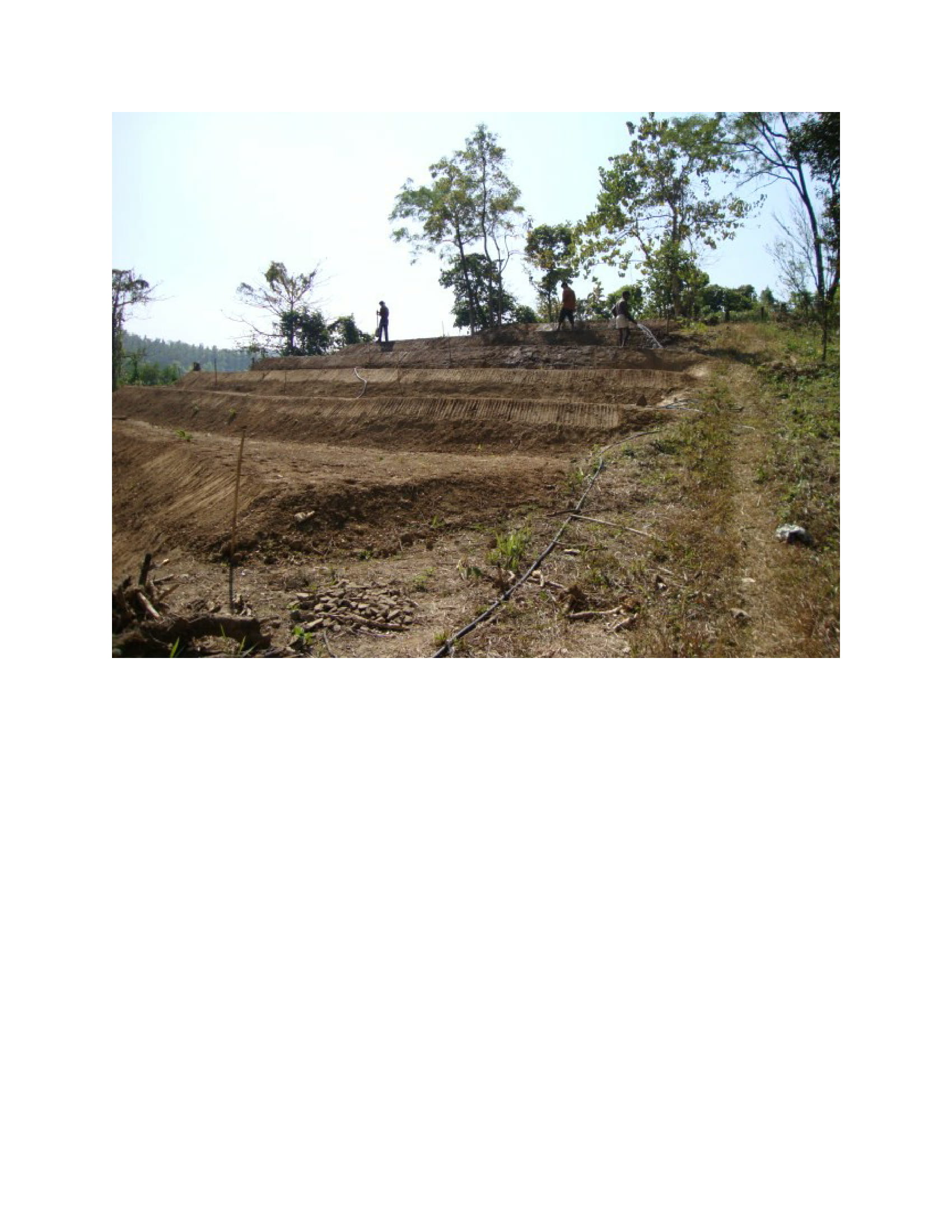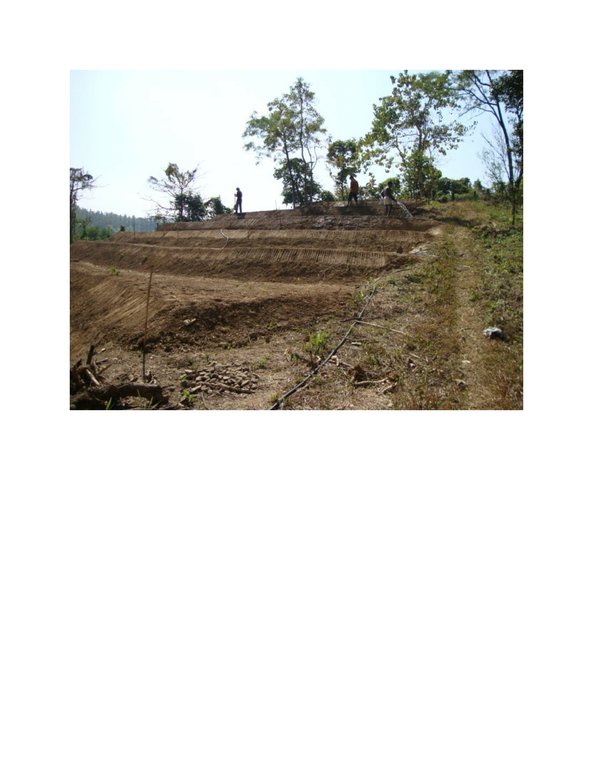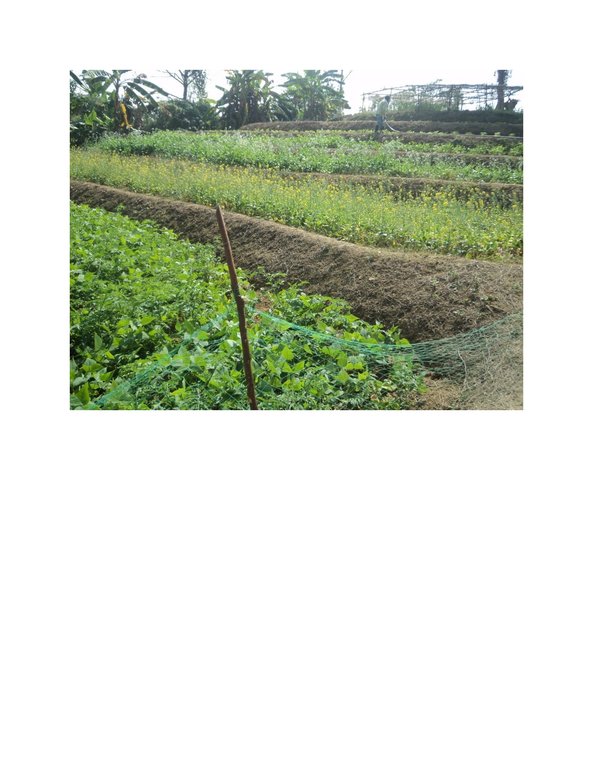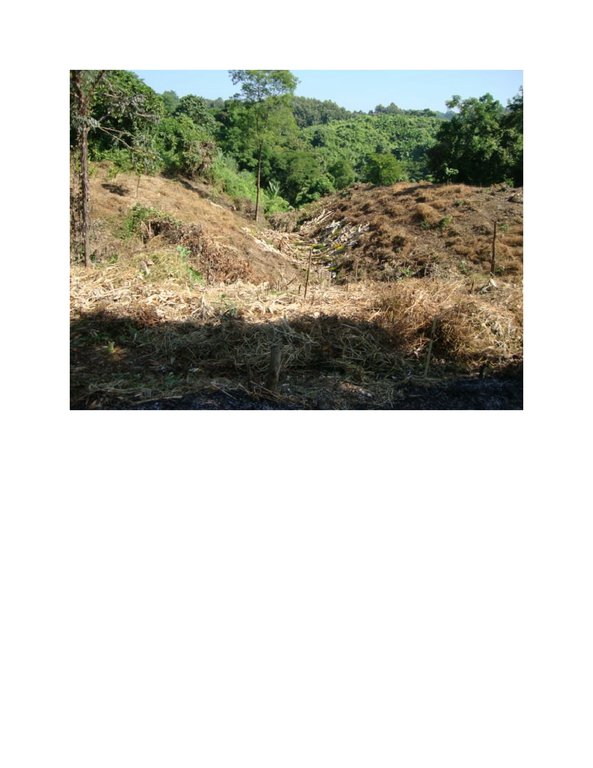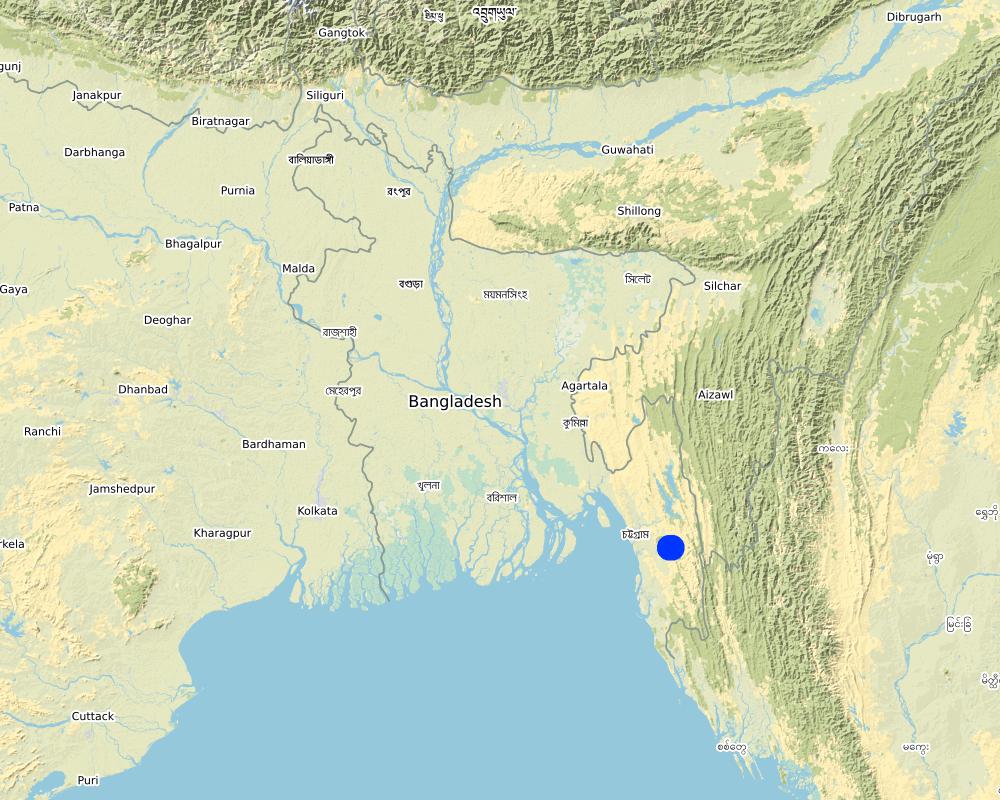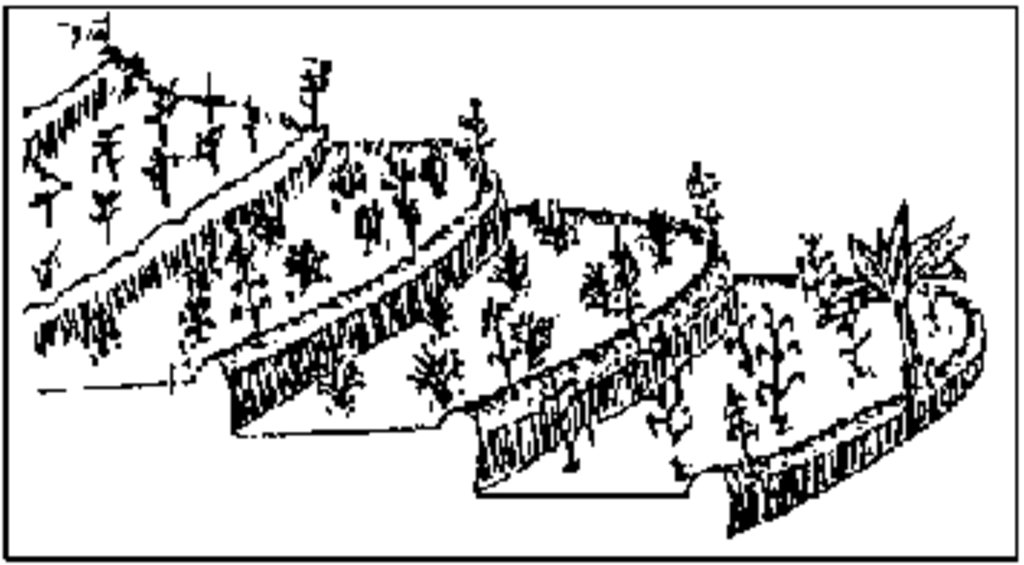Soil Conservation Through Bench Terrace Technology in Highly Degradable Hilly Slopy Areas of Bangladesh [บังกลาเทศ]
- ผู้สร้างสรรค์:
- การอัพเดท:
- ผู้รวบรวม: Md Babul Hossain
- ผู้เรียบเรียง: –
- ผู้ตรวจสอบ: Udo Höggel
"Dhap Poddoti" for soil erosion control in the highly degradable Chattagram Hill tract area of Bangladesh
technologies_4284 - บังกลาเทศ
ดูส่วนย่อย
ขยายทั้งหมด ย่อทั้งหมด1. ข้อมูลทั่วไป
1.2 รายละเอียดที่ติดต่อได้ของผู้รวบรวมและองค์กรที่เกี่ยวข้องในการประเมินและการจัดเตรียมทำเอกสารของเทคโนโลยี
ผู้เชี่ยวชาญ SLM:
Islam Mahabubul
Soil Resource Development Institute
บังกลาเทศ
ผู้ใช้ที่ดิน:
Chakma Ushalaya
Soil Resource Development Institute
บังกลาเทศ
co-compiler:
Md Zahid Ameer
Soil Resource Development Institute
บังกลาเทศ
ชื่อขององค์กรซึ่งอำนวยความสะดวกในการทำเอกสารหรือการประเมินเทคโนโลยี (ถ้าเกี่ยวข้อง)
Soil Resource Development Institute (SRDI) (Soil Resource Development Institute (SRDI)) - บังกลาเทศ1.3 เงื่อนไขการใช้ข้อมูลที่ได้บันทึกผ่านทาง WOCAT
ผู้รวบรวมและวิทยากรหลักยอมรับเงื่อนไขเกี่ยวกับการใช้ข้อมูลที่ถูกบันทึกผ่านทาง WOCAT:
ใช่
1.4 การเปิดเผยเรื่องความยั่งยืนของเทคโนโลยีที่ได้อธิบายไว้
เทคโนโลยีที่ได้อธิบายไว้นี้เป็นปัญหาของความเสื่อมโทรมโทรมของที่ดินหรือไม่ จึงไม่ได้รับการยอมรับว่าเป็นเทคโนโลยีเพื่อการจัดการที่ดินอย่างยั่งยืน:
ไม่ใช่
แสดงความคิดเห็น:
It is a very effective technology for soil conservation in hilly areas.
2. การอธิบายลักษณะของเทคโนโลยี SLM
2.1 การอธิบายแบบสั้น ๆ ของเทคโนโลยี
คำจำกัดความของเทคโนโลยี:
Bench terraces are a soil and water conservation measure used on sloping land with relatively deep soils to retain water and control erosion. They are normally constructed by cutting and filling to produce a series of level steps or benches. This allows water to infiltrate slowly into the soil. Bench terraces are reinforced by banks of soil or stone that block waterflow above the forward edges. This practice is typical for rice-based cropping systems.It is also helpful to increase the beauty of the land along with increasing the soil stability on these lands.
2.2 การอธิบายแบบละเอียดของเทคโนโลยี
คำอธิบาย:
The Chittagong Hill Tracts (CHT) are undergoing deforestation and land degradation arising from environmentally unsuitable activities such as tobacco cultivation in sloping land, shifting cultivation and logging. Shifting cultivation, also known as slash-and-burn agriculture. The present shifting cultivation system with short fallow in the Chittagong Hill Tracts has accelerated erosion, land degradation, deforestation, and impoverishment of tribal people in CHT. If the present state of degradation continues, most of the areas under shifting cultivation will be severely degraded and future generations will face more difficulties to eke out their livelihoods on further degraded land. That land shows massive erosion impact as influenced by shifting cultivation (Jhum) at steep and continuously sloping lands.
To address the aforesaid constraints in hilly areas of CHT, the Soil Conservation and Watershed Management Centre (SCWMC) of the Soil Resource Development Institute (SRDI) has developed the "Bench Terrace" technology. In this technology, some bench like terraces are made on the slopy land of hills where the slope angle is more than 30 degree. The width of the terraces ranges from 2.5 to 3.0 metre. The height of the terraces is 0.6 metre to 1 metre. An embankment constructed at the outer rim of the terraces prevents run off and soil loss over the outer edge of the terrace during heavy rain in the monsoon. The length of such terraces depends on the topographical contexts within which the terraces are constructed. The technology has various benefits:
- To reduce the quantum of overland flow/sheet flow or runoff, and their velocity.
- To minimize the soil erosion.
- To conserve soil moisture.
- To conserve soil fertility and to facilitate farming operations such as ploughing, irrigation etc. on sloping land.
- To promote intensive land use, permanent agriculture and checking shifting cultivation on steep lands.
- Bench terraces support proper water management and fertilizers/manure application. They will also help in increasing cropping intensity within a stable farming system.
The hill dwellers, who are the owners of the land, are practicing the technology because it has established a permanent solution for crop production instead shifting cultivation. The technology contributes to a reduction in land slides, soil erosion and to increased farm income. Bench Terraces are widely being used in the hilly areas of India, Nepal, Srilanka, Tamilnadu etc.
.
2.3 รูปภาพของเทคโนโลยี
2.5 ประเทศภูมิภาค หรือสถานที่ตั้งที่เทคโนโลยีได้นำไปใช้และได้รับการครอบคลุมโดยการประเมินนี้
ประเทศ:
บังกลาเทศ
ภูมิภาค/รัฐ/จังหวัด:
Bandarban
ข้อมูลจำเพาะเพิ่มเติมของสถานที่ตั้ง :
Its a region
ระบุการกระจายตัวของเทคโนโลยี:
- กระจายไปอย่างสม่ำเสมอในพื้นที่
If precise area is not known, indicate approximate area covered:
- 10-100 ตร.กม.
Is/are the technology site(s) located in a permanently protected area?
ไม่ใช่
แสดงความคิดเห็น:
This area is not under reserve forest area of Bangladesh forest department, instead it includes shifting cultivation areas of hill dwellers.
Map
×2.6 วันที่การดำเนินการ
ถ้าไม่รู้ปีที่แน่นอน ให้ระบุวันที่โดยประมาณ:
- น้อยกว่า 10 ปี (ไม่นานนี้)
2.7 คำแนะนำของเทคโนโลยี
ให้ระบุว่าเทคโนโลยีถูกแนะนำเข้ามาอย่างไร:
- ในช่วงการทดลองหรือการทำวิจัย
ความคิดเห็น (ประเภทของโครงการ เป็นต้น) :
Soil conservation and watershed management centre of soil resource development institute(SRDI) has developed the technology through long term research trial in farmers field as well as in research station.
3. การจัดประเภทของเทคโนโลยี SLM
3.1 วัตถุประสงค์หลักของเทคโนโลยี
- ปรับปรุงการผลิตให้ดีขึ้น
- ลด ป้องกัน ฟื้นฟู การเสื่อมโทรมของที่ดิน
- อนุรักษ์ระบบนิเวศน์
- ป้องกันพื้นที่ลุ่มน้ำ/บริเวณท้ายน้ำ โดยร่วมกับเทคโนโลยีอื่นๆ
- ลดความเสี่ยงของภัยพิบัติ
- สร้างผลกระทบทางด้านเศรษฐกิจที่เป็นประโยชน์
3.2 ประเภทของการใช้ที่ดินในปัจจุบันที่ได้นำเทคโนโลยีไปใช้
Land use mixed within the same land unit:
ไม่ใช่

ป่า/พื้นที่ทำไม้
- ป่ากึ่งธรรมชาติ / พื้นที่ทำไม้
(Semi-)natural forests/ woodlands: Specify management type:
- การเกษตรแบบไร่เลื่อยลอย (Shifting cultivation)
- การใช้ประโยชน์จากป่า ยกเว้นไม้
Are the trees specified above deciduous or evergreen?
- mixed deciduous/ evergreen
ผลิตภัณฑ์และบริการ:
- ไม้ที่นำมาทำเป็นเชื้อเพลิง
3.3 Has land use changed due to the implementation of the Technology?
Has land use changed due to the implementation of the Technology?
- Yes (Please fill out the questions below with regard to the land use before implementation of the Technology)
Land use mixed within the same land unit:
ใช่
Specify mixed land use (crops/ grazing/ trees):
- วนเกษตร (Agroforestry)

พื้นที่ปลูกพืช
- การปลูกพืชล้มลุกอายุปีเดียว
- การปลูกไม้ยืนต้น ไม้พุ่ม
Annual cropping - Specify crops:
- vegetables - leafy vegetables (salads, cabbage, spinach, other)
Annual cropping system:
Continuous vegetables
Tree and shrub cropping - Specify crops:
- citrus
Is intercropping practiced?
ไม่ใช่
Is crop rotation practiced?
ไม่ใช่
แสดงความคิดเห็น:
The land management and production system contains 3 cropping seasons per annum. The seasons are Rabi- Kharif1-Kharif-2.
3.4 การใช้น้ำ
การใช้น้ำของที่ดินที่มีการใช้เทคโนโลยีอยู่:
- น้ำฝนร่วมกับการชลประทาน
3.5 กลุ่ม SLM ที่ตรงกับเทคโนโลยีนี้
- การปลูกป่าร่วมกับพืช
- การรบกวนดินให้น้อยที่สุด
- มาตรการปลูกพืชขวางความลาดชัน (cross-slope measure)
3.6 มาตรการ SLM ที่ประกอบกันเป็นเทคโนโลยี

มาตรการอนุรักษ์ด้วยโครงสร้าง
- S1: คันดิน
3.7 รูปแบบหลักของการเสื่อมโทรมของที่ดินที่ได้รับการแก้ไขโดยเทคโนโลยี

การกัดกร่อนของดินโดยน้ำ
- Wt (Loss of topsoil): การสูญเสียดินชั้นบนหรือการกัดกร่อนที่ผิวดิน
- Wg (Gully erosion): การกัดกร่อนแบบร่องธารหรือการทำให้เกิดร่องน้ำเซาะ
3.8 การป้องกัน การลดลง หรือการฟื้นฟูความเสื่อมโทรมของที่ดิน
ระบุเป้าหมายของเทคโนโลยีกับความเสื่อมโทรมของที่ดิน:
- ลดความเสื่อมโทรมของดิน
4. ข้อมูลจำเพาะด้านเทคนิค กิจกรรมการนำไปปฏิบัติใช้ ปัจจัยนำเข้า และค่าใช้จ่าย
4.1 แบบแปลนทางเทคนิคของเทคโนโลยี
ข้อมูลจำเพาะด้านเทคนิค (แบบแปลนทางเทคนิคของเทคโนโลยี):
According to the hill slope, the height, width (depth) and length of terrace can vary. Generally the width (depth) of a terrace is 2.5- 3 metre, the height is 1 metre and slope angle 10 to 15 degree. The contour is established by uplifting soil in a straight line and the wall is constructed by mud. The floor area is leveled and cultivated with spade or plough. Generally the floor area of a bench terrace is 40 square metres. An access path is kept open from one corner of the terrace.
The horizontal orientation of the terraces follow the contour line of the slope. That contour line is an imaginary line perpendicular to the sloping direction (uphill to downhill) of an area. The contour line runs horizontally along the slope of a farm.
Viewed from an opposite the face of the slope, all contour lines will appear horizontally. However, viewed from uphill, the lines may either be straight, curved like the outside of a sphere, or curved irregularly downward or upward depending on the presence of low- and high-lying surfaces on the face of the slope.
4.2 ข้อมูลทั่วไปเกี่ยวกับการคำนวณปัจจัยนำเข้าและค่าใช้จ่าย
ให้ระบุว่าค่าใช้จ่ายและปัจจัยนำเข้าได้รับการคำนวณอย่างไร:
- ต่อพื้นที่ที่ใช้เทคโนโลยี
ระบุขนาดและหน่วยพื้นที่:
1 acre
อื่นๆ หรือสกุลเงินประจำชาติ (ระบุ):
Taka( Bangladeshi currency)
If relevant, indicate exchange rate from USD to local currency (e.g. 1 USD = 79.9 Brazilian Real): 1 USD =:
80.0
ระบุค่าเฉลี่ยของค่าจ้างในการจ้างแรงงานต่อวัน:
500 taka
4.3 กิจกรรมเพื่อการจัดตั้ง
| กิจกรรม | Timing (season) | |
|---|---|---|
| 1. | Cleaning forest | Before making the terraces |
| 2. | Earth cutting | Before raining season |
| 3. | Making terraces | |
| 4. | Land preparation | every season |
| 5. | fertiliser application | every season |
| 6. | seed sowing | every season |
| 7. | Irrigation | 5 times per cropping season |
| 8. | Intercultural operation | occassionally |
| 9. | Reconstruction of terraces | Before rainy season |
4.4 ค่าใช้จ่ายของปัจจัยนำเข้าที่จำเป็นสำหรับการจัดตั้ง
| ปัจจัยนำเข้า | หน่วย | ปริมาณ | ค่าใช้จ่ายต่อหน่วย | ค่าใช้จ่ายทั้งหมดต่อปัจจัยนำเข้า | %ของค่าใช้จ่ายที่ก่อให้เกิดขึ้นโดยผู้ใช้ที่ดิน | |
|---|---|---|---|---|---|---|
| แรงงาน | Cleaning forest | persons-per day | 5.0 | 500.0 | 2500.0 | 100.0 |
| แรงงาน | Earth cutting | persons-per day | 4.0 | 500.0 | 2000.0 | 100.0 |
| แรงงาน | Making terraces | persons-per day | 5.0 | 500.0 | 2500.0 | 100.0 |
| แรงงาน | Land preparation | persons-per day | 3.0 | 500.0 | 1500.0 | 100.0 |
| อุปกรณ์ | fertiliser application | persons-per day | 1.0 | 500.0 | 500.0 | 50.0 |
| อุปกรณ์ | seed sowing | persons-per day | 2.0 | 500.0 | 1000.0 | 30.0 |
| อุปกรณ์ | Irrigation | persons-per day | 3.0 | 500.0 | 1500.0 | 70.0 |
| อุปกรณ์ | Intercultural operation | persons-per day | 4.0 | 500.0 | 2000.0 | 100.0 |
| อุปกรณ์ | Machine operated cleaning tools | Number | 1.0 | 4000.0 | 4000.0 | 50.0 |
| อุปกรณ์ | spade | Number | 5.0 | 300.0 | 1500.0 | 100.0 |
| อุปกรณ์ | mower | Number | 1.0 | 2000.0 | 2000.0 | 100.0 |
| อุปกรณ์ | sickle | Number | 5.0 | 200.0 | 1000.0 | 100.0 |
| วัสดุด้านพืช | Tape | Piece | 2.0 | 100.0 | 200.0 | 100.0 |
| วัสดุด้านพืช | rope | piece | 2.0 | 50.0 | 100.0 | 100.0 |
| วัสดุด้านพืช | seed | Kg | 0.5 | 300.0 | 150.0 | |
| วัสดุด้านพืช | seedlings | Number | 50.0 | 50.0 | 2500.0 | |
| ปุ๋ยและสารฆ่า/ยับยั้งการเจริญเติบโตของสิ่งมีชีวิต (ไบโอไซด์) | Nitrogen | Kg | 20.0 | 16.0 | 320.0 | 70.0 |
| ปุ๋ยและสารฆ่า/ยับยั้งการเจริญเติบโตของสิ่งมีชีวิต (ไบโอไซด์) | Phosphorus | Kg | 10.0 | 22.0 | 220.0 | 70.0 |
| ปุ๋ยและสารฆ่า/ยับยั้งการเจริญเติบโตของสิ่งมีชีวิต (ไบโอไซด์) | potassium | Kg | 15.0 | 30.0 | 450.0 | 70.0 |
| ปุ๋ยและสารฆ่า/ยับยั้งการเจริญเติบโตของสิ่งมีชีวิต (ไบโอไซด์) | Compost | Ton | 1.0 | 1000.0 | 1000.0 | 100.0 |
| วัสดุสำหรับก่อสร้าง | pesticide | Kg | 0.5 | 200.0 | 100.0 | 50.0 |
| วัสดุสำหรับก่อสร้าง | pipes | Number | 5.0 | 400.0 | 2000.0 | 50.0 |
| ค่าใช้จ่ายทั้งหมดของการจัดตั้งเทคโนโลยี | 29040.0 | |||||
| Total costs for establishment of the Technology in USD | 363.0 | |||||
ถ้าผู้ใช้ที่ดินรับภาระน้อยกว่า 100% ของค่าใช้จ่าย ให้ระบุว่าใครเป็นผู้รับผิดชอบส่วนที่เหลือ:
Department of Agriculture Extension and other Government and non Government organisation
แสดงความคิดเห็น:
The Government organisations always encourage the land owners to practice the technology by giving a portion of inputs.
4.5 การบำรุงรักษาสภาพหรือกิจกรรมที่เกิดขึ้นเป็นประจำ
| กิจกรรม | ช่วงระยะเวลา/ความถี่ | |
|---|---|---|
| 1. | Reconstruction of terraces | Before rainy season |
4.6 ค่าใช้จ่ายของปัจจัยนำเข้าและกิจกรรมที่เกิดขึ้นเป็นประจำที่ต้องการการบำรุงรักษา (ต่อปี)
| ปัจจัยนำเข้า | หน่วย | ปริมาณ | ค่าใช้จ่ายต่อหน่วย | ค่าใช้จ่ายทั้งหมดต่อปัจจัยนำเข้า | %ของค่าใช้จ่ายที่ก่อให้เกิดขึ้นโดยผู้ใช้ที่ดิน | |
|---|---|---|---|---|---|---|
| แรงงาน | Reconstruction of terraces | Persons-per day | 2.0 | 500.0 | 1000.0 | 80.0 |
| ค่าใช้จ่ายทั้งหมดของการบำรุงรักษาสภาพเทคโนโลยี | 1000.0 | |||||
| Total costs for maintenance of the Technology in USD | 12.5 | |||||
4.7 ปัจจัยสำคัญที่สุดที่มีผลกระทบต่อค่าใช้จ่าย
ปัจจัยสำคัญที่สุดที่มีผลกระทบต่อค่าใช้จ่ายต่างๆ:
Labour cost is the most important factor that affects the total cost.
5. สิ่งแวดล้อมทางธรรมชาติและของมนุษย์
5.1 ภูมิอากาศ
ฝนประจำปี
- < 250 ม.ม.
- 251-500 ม.ม.
- 501-750 ม.ม.
- 751-1,000 ม.ม.
- 1,001-1,500 ม.ม.
- 1,501-2,000 ม.ม.
- 2,001-3,000 ม.ม.
- 3,001-4,000 ม.ม.
- > 4,000 ม.ม.
เขตภูมิอากาศเกษตร
- กึ่งชุ่มชื้น
Mean annual temperature 27 degree celcius
5.2 สภาพภูมิประเทศ
ค่าเฉลี่ยความลาดชัน:
- ราบเรียบ (0-2%)
- ลาดที่ไม่ชัน (3-5%)
- ปานกลาง (6-10%)
- เป็นลูกคลื่น (11-15%)
- เป็นเนิน (16-30%)
- ชัน (31-60%)
- ชันมาก (>60%)
ธรณีสัณฐาน:
- ที่ราบสูง/ที่ราบ
- สันเขา
- ไหล่เขา
- ไหล่เนินเขา
- ตีนเนิน
- หุบเขา
ระดับความสูง:
- 0-100 เมตร
- 101-500 เมตร
- 501-1,000 เมตร
- 1,001-1,500 เมตร
- 1,501-2,000 เมตร
- 2,001-2,500 เมตร
- 2,501-3,000 เมตร
- 3,001-4,000 เมตร
- > 4,000 เมตร
ให้ระบุถ้าเทคโนโลยีได้ถูกนำไปใช้:
- ไม่เกี่ยวข้อง
5.3 ดิน
ค่าเฉลี่ยความลึกของดิน:
- ตื้นมาก (0-20 ซ.ม.)
- ตื้น (21-50 ซ.ม.)
- ลึกปานกลาง (51-80 ซ.ม.)
- ลึก (81-120 ซ.ม.)
- ลึกมาก (>120 ซ.ม.)
เนื้อดิน (ดินชั้นบน):
- ปานกลาง (ดินร่วน ทรายแป้ง)
เนื้อดินล่าง (> 20 ซ.ม.ต่ำจากผิวดิน):
- ปานกลาง (ดินร่วน ทรายแป้ง)
อินทรียวัตถุในดิน:
- ต่ำ (<1%)
(ถ้ามี) ให้แนบคำอธิบายเรื่องดินแบบเต็มหรือระบุข้อมูลที่มีอยู่ เช่น ชนิดของดิน ค่า pH ของดินหรือความเป็นกรดของดิน ความสามารถในการแลกเปลี่ยนประจุบวก ไนโตรเจน ความเค็ม เป็นต้น:
soils are clay loam to clay, soils are acidic in nature, nitrogen content in most cases low and presence of no salinity. Land type -very high
5.4 ความเป็นประโยชน์และคุณภาพของน้ำ
ระดับน้ำใต้ดิน:
> 50 เมตร
น้ำไหลบ่าที่ผิวดิน:
ไม่ดีหรือไม่มีเลย
คุณภาพน้ำ (ที่ยังไม่ได้บำบัด):
เป็นน้ำเพื่อการดื่มที่ไม่ดี (จำเป็นต้องได้รับการบำบัด)
Water quality refers to:
ground water
ความเค็มของน้ำเป็นปัญหาหรือไม่:
ไม่ใช่
กำลังเกิดน้ำท่วมในพื้นที่หรือไม่:
ไม่ใช่
5.5 ความหลากหลายทางชีวภาพ
ความหลากหลายทางชนิดพันธุ์:
- ปานกลาง
ความหลากหลายของแหล่งที่อยู่:
- ปานกลาง
5.6 ลักษณะของผู้ใช้ที่ดินที่นำเทคโนโลยีไปปฏิบัติใช้
อยู่กับที่หรือเร่ร่อน:
- อยู่กับที่
แนวทางการตลาดของระบบการผลิต:
- เพื่อการยังชีพ (หาเลี้ยงตนเอง)
รายได้ที่มาจากนอกฟาร์ม:
- 10-50% ของรายได้ทั้งหมด
ระดับของความมั่งคั่งโดยเปรียบเทียบ:
- พอมีพอกิน
เป็นรายบุคคล/ครัวเรือน:
- เป็นรายบุคคล/ครัวเรือน
ระดับของการใช้เครื่องจักรกล:
- งานที่ใช้แรงกาย
เพศ:
- หญิง
อายุของผู้ใช้ที่ดิน:
- วัยกลางคน
5.7 Average area of land used by land users applying the Technology
- < 0.5 เฮกตาร์
- 0.5-1 เฮกตาร์
- 1-2 เฮกตาร์
- 2-5 เฮกตาร์
- 5-15 เฮกตาร์
- 15-50 เฮกตาร์
- 50-100 เฮกตาร์
- 100-500 เฮกตาร์
- 500-1,000 เฮกตาร์
- 1,000-10,000 เฮกตาร์
- >10,000 เฮกตาร์
พิจารณาว่าเป็นขนาดเล็ก กลาง หรือขนาดใหญ่ (ซึ่งอ้างอิงถึงบริบทระดับท้องถิ่น):
- ขนาดเล็ก
5.8 กรรมสิทธิ์ในที่ดิน สิทธิในการใช้ที่ดินและสิทธิในการใช้น้ำ
กรรมสิทธิ์ในที่ดิน:
- รายบุคคล ไม่ได้รับสิทธิครอบครอง
- รายบุคคล ได้รับสิทธิครอบครอง
สิทธิในการใช้ที่ดิน:
- รายบุคคล
สิทธิในการใช้น้ำ:
- เข้าถึงได้แบบเปิด (ไม่ได้จัดระเบียบ)
Are land use rights based on a traditional legal system?
ใช่
5.9 การเข้าถึงบริการและโครงสร้างพื้นฐาน
สุขภาพ:
- จน
- ปานกลาง
- ดี
การศึกษา:
- จน
- ปานกลาง
- ดี
ความช่วยเหลือทางด้านเทคนิค:
- จน
- ปานกลาง
- ดี
การจ้างงาน (เช่น ภายนอกฟาร์ม):
- จน
- ปานกลาง
- ดี
ตลาด:
- จน
- ปานกลาง
- ดี
พลังงาน:
- จน
- ปานกลาง
- ดี
ถนนและการขนส่ง:
- จน
- ปานกลาง
- ดี
น้ำดื่มและการสุขาภิบาล:
- จน
- ปานกลาง
- ดี
บริการด้านการเงิน:
- จน
- ปานกลาง
- ดี
6. ผลกระทบและสรุปคำบอกกล่าว
6.1 ผลกระทบในพื้นที่ดำเนินการ (On-site) จากการใช้เทคโนโลยี
ผลกระทบทางด้านเศรษฐกิจและสังคม
การผลิต
การผลิตพืชผล
การเสี่ยงต่อความล้มเหลวในการผลิต
พื้นที่สำหรับการผลิต
การจัดการที่ดิน
แสดงความคิดเห็น/ระบุ:
In hilly area , due to slopy land , it is difficult to manage because soil erosion is higher in rainy season, there are no structures to reduce soil erosion. But, due to the establishment of bench terraces, soil erosion in rainy season is significantly checked and long slopy stretches are interupted by a soil stabilising structure. In this way , land management is simplified.
รายได้และค่าใช้จ่าย
ค่าใช่จ่ายของปัจจัยการผลิตทางการเกษตร
รายได้จากฟาร์ม
ความหลากหลายของแหล่งผลิตรายได้
ความเหลื่อมล้ำทางเศรษฐกิจ
ภาระงาน
ผลกระทบด้านสังคมวัฒนธรรมอื่น ๆ
ความมั่นคงด้านอาหาร / พึ่งตนเองได้
สถานการณ์ด้านสุขภาพ
การใช้ที่ดิน / สิทธิในการใช้น้ำ
โอกาสทางวัฒนธรรม
โอกาสทางด้านสันทนาการ
แสดงความคิดเห็น/ระบุ:
As the economic situation is improved through increased crop production due to this method, the land owners will beneift from new opportunities for recreational programmes.
สถาบันของชุมชน
สถาบันแห่งชาติ
SLM หรือความรู้เรื่องความเสื่อมโทรมของที่ดิน
การบรรเทาความขัดแย้ง
สถานการณ์ของกลุ่มด้อยโอกาส ทางด้านสังคมและเศรษฐกิจ
ผลกระทบด้านนิเวศวิทยา
ดิน
ความชื้นในดิน
สิ่งปกคลุมดิน
การสูญเสียดิน
การสะสมของดิน
การหมุนเวียนและการเติมของธาตุอาหาร
อินทรียวัตถุในดิน/ต่ำกว่าดินชั้น C
ความเป็นกรด
แสดงความคิดเห็น/ระบุ:
As the land owners use balanced fertiliser , with proper irrigation and other intercultural operations, so, soil acidity will reduce a little bit.
ความหลากหลายทางชีวภาพของพืชและสัตว์
การปกคลุมด้วยพืช
มวลชีวภาพ/เหนือดินชั้น C
ความหลากหลายทางชีวภาพของพืช
ความหลากหลายทางชีวภาพของสัตว์
แสดงความคิดเห็น/ระบุ:
As planned cropping system is going to be established in bench terrace land management system, so soil flora and fauna will get a suitable environment to grow.
ชนิดพันธุ์ที่ให้ประโยชน์
ความหลากหลายของสัตว์
การจัดการศัตรูพืชและโรคพืช
ลดความเสี่ยงของภัยพิบัติ
ดินถล่ม/ ซากต่าง ๆ ที่ถูกพัดพามา
ผลกระทบจากภัยแล้ง
การปล่อยคาร์บอนและก๊าซเรือนกระจก
แสดงความคิดเห็น/ระบุ:
In this production system, cropping intensity is increased 2-3 times and the crops are absorbing more CO2 for photosynthesis. So, carbon emission will reduce.
ความเสี่ยงจากไฟ
ภูมิอากาศจุลภาค
6.2 ผลกระทบนอกพื้นที่ดำเนินการ (Off-site) จากการใช้เทคโนโลยี
การทับถมของดินตะกอนพื้นที่ท้ายน้ำ
ความเสียหายต่อพื้นที่เพาะปลูกของเพื่อนบ้าน
ความเสียหายต่อโครงสร้างพื้นฐานของรัฐหรือของเอกชน
ผลกระทบของก๊าซเรือนกระจก
แสดงความคิดเห็น/ระบุ:
In this production system, cropping intensity is increased 2-3 times and the crops are absorbing more co2 for photosynthesis. So, carbon emission will reduce.
6.3 การเผชิญและความตอบสนองของเทคโนโลยีต่อการเปลี่ยนแปลงสภาพภูมิอากาศที่ค่อยเป็นค่อยไป และสภาพรุนแรงของภูมิอากาศ / ภัยพิบัติ (ที่รับรู้ได้โดยผู้ใช้ที่ดิน)
การเปลี่ยนแปลงสภาพภูมิอากาศที่ค่อยเป็นค่อยไป
การเปลี่ยนแปลงสภาพภูมิอากาศที่ค่อยเป็นค่อยไป
| ฤดู | increase or decrease | เทคโนโลยีมีวิธีการรับมืออย่างไร | |
|---|---|---|---|
| อุณหภูมิประจำปี | เพิ่มขึ้น | ปานกลาง | |
| อุณหภูมิตามฤดูกาล | ฤดูร้อน | เพิ่มขึ้น | ดี |
| ฝนประจำปี | เพิ่มขึ้น | ปานกลาง | |
| ฝนตามฤดู | ฤดูฝน | ลดลง | ปานกลาง |
สภาพรุนแรงของภูมิอากาศ (ภัยพิบัติ)
ภัยพิบัติทางอุตุนิยมวิทยา
| เทคโนโลยีมีวิธีการรับมืออย่างไร | |
|---|---|
| พายุเขตร้อน | ปานกลาง |
| พายุฝนประจำท้องถิ่น | ดี |
| พายุฝนฟ้าคะนองประจำท้องถิ่น | ปานกลาง |
| พายุลูกเห็บประจำท้องถิ่น | ดีมาก |
| พายุลมประจำท้องถิ่น | ปานกลาง |
ภัยพิบัติจากสภาพภูมิอากาศ
| เทคโนโลยีมีวิธีการรับมืออย่างไร | |
|---|---|
| ภัยจากฝนแล้ง | ปานกลาง |
| ไฟป่า | ปานกลาง |
| ไฟบนบก | ดี |
ภัยพิบัติจากน้ำ
| เทคโนโลยีมีวิธีการรับมืออย่างไร | |
|---|---|
| ดินถล่ม | ดีมาก |
ภัยพิบัติทางชีวภาพ
| เทคโนโลยีมีวิธีการรับมืออย่างไร | |
|---|---|
| การบุกรุกของแมลง / หนอน | ดี |
6.4 การวิเคราะห์ค่าใช้จ่ายและผลประโยชน์ที่ได้รับ
ผลประโยชน์ที่ได้รับเปรียบเทียบกับค่าใช้จ่ายในการจัดตั้งเป็นอย่างไร (จากมุมมองของผู้ใช้ที่ดิน)
ผลตอบแทนระยะสั้น:
ด้านบวก
ผลตอบแทนระยะยาว:
ด้านบวกอย่างมาก
ผลประโยชน์ที่ได้รับเปรียบเทียบกับค่าใช้จ่ายในการบำรุงรักษาหรือต้นทุนที่เกิดขึ้นซ้ำอีก เป็นอย่างไร (จากมุมมองของผู้ใช้ที่ดิน)
ผลตอบแทนระยะสั้น:
ด้านบวกอย่างมาก
ผลตอบแทนระยะยาว:
ด้านบวกอย่างมาก
6.5 การปรับตัวของเทคโนโลยี
- > 50%
Of all those who have adopted the Technology, how many did so spontaneously, i.e. without receiving any material incentives/ payments?
- 11-50%
6.6 การปรับตัว
เทคโนโลยีได้รับการปรับเปลี่ยนเมื่อเร็วๆนี้ เพื่อให้ปรับตัวเข้ากับสภาพที่กำลังเปลี่ยนแปลงหรือไม่:
ไม่ใช่
6.7 จุดแข็ง / ข้อได้เปรียบ / โอกาสของเทคโนโลยี
| จุดแข็ง / ข้อได้เปรียบ / โอกาสในทัศนคติของผู้ใช้ที่ดิน |
|---|
| Risk of land slide reduced |
| Farm income increased |
| จุดแข็ง / ข้อได้เปรียบ / โอกาสในทัศนคติของผู้รวบรวมหรือวิทยากรหลัก |
|---|
| Soil erosion decreased |
| Crop production increased |
| Soil nutrient mining reduced |
| Soil nutrient availability enhanced |
| Soil moisture increased |
| Irrigation water use efficiency increased |
6.8 จุดอ่อน / ข้อเสียเปรียบ / ความเสี่ยงของเทคโนโลยีและวิธีการแก้ไข
| จุดอ่อน / ข้อเสียเปรียบ / ความเสี่ยงในทัศนคติของผู้ใช้ที่ดิน | มีวิธีการแก้ไขได้อย่างไร |
|---|---|
| Labour cost very high | Borrow money from financial institution |
| จุดอ่อน / ข้อเสียเปรียบ / ความเสี่ยงในทัศนคติของผู้รวบรวมหรือวิทยากรหลัก | มีวิธีการแก้ไขได้อย่างไร |
|---|---|
| Lack of knowledge regarding land management in slopy hilly areas | Take part in related training |
| Labour unavailability and labour cost is higher | Engaged family members |
7. การอ้างอิงและการเชื่อมต่อ
7.1 วิธีการและแหล่งข้อมูล
- ไปเยี่ยมชมภาคสนาม การสำรวจพื้นที่ภาคสนาม
10
- การสัมภาษณ์ผู้เชี่ยวชาญด้าน SLM หรือผู้ชำนาญ
10
- การเก็บรวบรวมมาจากรายงานและเอกสารที่มีอยู่
5
วันที่เก็บรวบรวมข้อมูล(ภาคสนาม) :
16/04/2018
7.2 การอ้างอิงถึงสิ่งตีพิมพ์
หัวข้อ, ผู้เขียน, ปี, หมายเลข ISBN:
Soil erosion in hilly areas affecting biodiversity and climate change and its biological conservation strategy,Md. Mijanur Rahman Wildlife Conservation Officer Coastal & Wetland Biodiversity Management Project Department of Environment, Teknaf, Cox’s Bazar
ชื่อเรื่อง ผู้เขียน ปี ISBN:
FAO, 1978. Soil erosion by water. FAO, United Nations. PP. 63-111 Khan, L.R. Watershed management. Field document no.44. UNDP/FAO/BGD/85/011. PP.151-193 Negi, S.S. 1983. Soil conservation. Fundamental of forestry volume.3. Rahman, M.M. 1994. A review paper on erosion control measures in hilly areas. FWT discipline, Khulna University, Khulna, Bangladesh Young, Anthony. 1989. Agro forestry for soil conservation. ICRAF.
หัวข้อ, ผู้เขียน, ปี, หมายเลข ISBN:
Soil erosion in the Chittagong hill tract and its impact on nutrient status of soils [in Bangladesh] [1992],Farid, A.T.M. Iqbal, A. Karim, Z.
ชื่อเรื่อง ผู้เขียน ปี ISBN:
AGRIS, FAO
7.3 Links to relevant online information
ชื่อเรื่องหรือคำอธิบาย:
A review of the effect of terracing on erosion,
URL:
https://www.researchgate.net/profile/Luuk_Dorren
7.4 General comments
The questionnaire should be more generalised so that all the land degradation specialists can fill up the document smoothly.
ลิงก์และโมดูล
ขยายทั้งหมด ย่อทั้งหมดลิงก์
ไม่มีลิงก์
โมดูล
ไม่มีโมดูล


